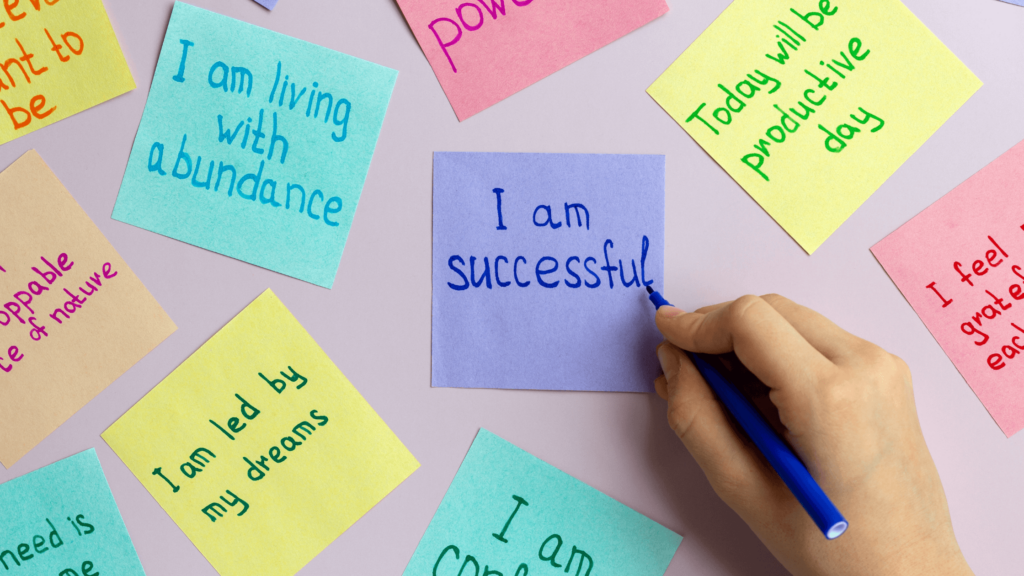Manifesting can be a powerful tool in which you focus on your goals to make your dreams a reality. While this practice often earns eye-rolls and skepticism, it’s also used by elite athletes and neuroscientists who recognize the power of the mind to create reality. You can manifest by creating a vision board, journaling, using positive affirmations, or learning the 3-6-9 method. While it isn’t like having your wishes granted by a genie, it can feel just as magical.
Quick look
- Manifestation is the process of setting a goal or intention, then repeating it and focusing on it to make it a reality.
- Manifesting can work through the law of attraction and the power of visualization.
- Limiting beliefs and self-fulfilling prophecies can inhibit your progress and curtail your dreams.
- You can use vision boards, journaling, positive affirmations, or learning the 3-6-9 method to manifest.
What is manifestation?

Manifestation is the practice of willing something into existence simply by thinking about it. Believing in manifestation may sound bizarre or even implausible (like believing in Santa Claus or the Easter Bunny), but before rolling your eyes and dismissing the practice altogether, it might interest you to know that it does have some surprising scientific backing.
Before diving into that—and why some neuroscientists are devoted manifestation practitioners—let’s explore how manifestation works.
How does manifesting work?
Several theories explain why manifestation can be an effective way to create positive change in your life. You may have heard about the law of attraction in the 2006 film The Secret. This movie focused on the idea that positive thoughts attract positive outcomes, and negative thoughts attract negative outcomes.
In some ways, this makes sense. If you have a pessimistic outlook, often express negative opinions about others, or spend a lot of time complaining, you may attract others who do the same while repelling those with a more positive attitude. After all, misery loves company. Your negativity will attract more negativity.
Visualization is a form of manifestation that professional athletes have used in their training programs for decades. In addition to grueling practices and repetitive drills, some of the best athletes in the world spend hours visualizing successful ski jumps, perfect gymnastic routines, and enviable nothing-but-net hoop shots. Visualization works so well that most elite coaches and top sports psychologists use it.
Manifesting isn’t always positive, however. There are also unconscious ways of manifesting, where you unwittingly focus so much on what you don’t want that it ends up happening. We often call these phenomena self-fulfilling prophecies. Imagine being so worried about your partner leaving you that you constantly ask for reassurance, snoop for evidence of waning attraction, and drastically limit their social life because you fear them finding someone better.
Your actions may eventually become so suffocating that they push your partner to leave the relationship, creating precisely the situation you were trying to avoid.
Similarly, focusing so heavily on avoiding material delays, weather challenges, and other setbacks inevitably brings them to the job site and pushes back the project deadline several weeks—precisely what the builder didn’t want.
When you break it down, manifestation isn’t such a crazy idea. It’s just taking control of phenomena that may already be present in your life.
The dark side of limiting beliefs
Your thoughts can increase athletic performance and attract different energies, and may also be responsible for curtailing your potential. Limiting beliefs are ideas or opinions about yourself that prevent you from achieving your full potential. These beliefs can sound like I’m not smart enough, I’m too old, or I don’t deserve that promotion.
Psychologist Robert M. Williams says, “Your beliefs have far-reaching consequences, both positive and negative, in your life. Beliefs affect your moods, relationships, job performance, self-esteem, physical health, even your religious or spiritual outlook.”
Identifying your self-limiting beliefs is the first step to changing them and overcoming their effect on your life. Manifestation can help you overcome limiting beliefs by helping you believe good things about yourself and your potential to achieve, find love, and live a fulfilling life.
Getting started with manifestation
So, now that we’ve successfully inserted just the tiniest sliver of doubt into your stone-cold skepticism, you might wonder how this whole thing works. How exactly do you ✨manifest✨?
Start where you are
The great thing about manifestation is that it doesn’t require you to invest anything besides a few minutes of your time. There’s no cost, no risk, no barrier to entry. To start manifesting, you can just begin precisely where you are. What do you have to lose?
Get clear about what you want
As suggested above, throw out goals around material possessions or external affirmation. Shift from thinking about goals that would make other people proud, envious, or attracted to you, and instead, ask yourself what you really want. Maybe you’ve always wanted to paint. Perhaps you want to go back to school or challenge yourself to run 5k. Maybe you want to start dating and meet someone to share your life with. Or perhaps you want to set yourself up for a big promotion. Whatever the goal, make sure it reflects your true desires.
Make time
Part of what makes manifestation effective is deeply embedding your goal into your brain through intention and repetition. Set a time to practice manifesting—it can be on the bus to work, right before bed, or even on Sundays at the end of a weekend. Tying your manifestation practice to another habit, like brushing your teeth or walking the dog, can help you remember—a technique called habit stacking.
Manifestation for beginners: 4 techniques to try
If you’re still stuck on where to start, here are some ideas.
1. Vision board

If you’ve never made a vision board, get ready to flex your crafting muscles! This method of manifestation is ideal for visual learners. Get a stack of old magazines or newspapers and cut out words and pictures to represent your goal(s). If you want to go back to school, you might include images of students, learning, and books, as well as more conceptual images that represent taking a leap of faith or expanding your horizons.
Next, glue the clippings to a piece of paper or poster board to create a collage. This is your vision board! Hang it somewhere you’ll see it every day. It will remind you of your goals and help you manifest them into reality.
Pro tip: If you’re not into the crafting aspect of a vision board, go digital! Cut and paste photos from the web into a document and create a digital collage of your dreams.
2. Journaling

Journaling can be a great way to practice manifestation. To encourage yourself to commit to the practice, get a new journal specifically for manifestations or use a notepad you already own (just make sure it’s dedicated solely to this purpose).
How you write in your journal will be different from your typical diary-style writing. Some experts recommend writing your manifestations in detail as if they are already happening. Write in the present tense and use descriptive language, imagining how this new reality will look, smell, taste, and feel—almost like writing down the contents of a visualization exercise. Do this as often as possible (preferably every day) for the best results.
3. Positive affirmations

Positive affirmations can be an effective way to counteract limiting beliefs. They are often spoken aloud and sometimes while looking in the mirror, which helps connect the words to the person you’re talking about (and to)—you!
Positive affirmations can help reinforce your confidence by contradicting limiting beliefs (like saying “I deserve to be loved” out loud instead of retaining the belief that no one will ever want you). Affirmations can also be used to manifest by serving like a shorter, verbal version of your journaling practice. Positive affirmations for manifestation could sound simple, like “ I am confident,” or specific, like “Every day I get closer to getting my dream job.”
4. 369 manifestation method

Popularized on TikTok, the 3-6-9 manifestation method involved writing down your goals three times in the morning, six times throughout the day, and nine times before bed. While this method is the most involved (and might not be ideal for those who work full-time on a busy worksite), devotees of the 3-6-9 method rave about its life-changing potential.
Does manifestation work?
According to James R. Doty, a physician and neuroscientist who wrote the book about manifestation, this technique is not only a realistic way of identifying and achieving one’s goals—it can also be life-altering.
In an interview with Self Magazine, Dr. Doty explains that manifestation is far from a weird, woo-woo idea. It works by embedding a goal in your brain so that your subconscious gathers the tools to make it possible, notices opportunities you may have otherwise missed, and creates new neural pathways in the process.
Remember that manifestation is a tool, not a magic wand. Goals like winning the lottery or owning a Lamborghini aren’t ideal for manifestation because they often come from a place of insecurity or scarcity. Instead, think of a goal that will bring you deep purpose or happiness, and “Write it down, read it silently, read it aloud, visualize yourself achieving it, and repeat the intention over and over again,” to make it happen.
Bottom line
Using manifestation to achieve your goals is a powerful way to make your goals a reality. While it doesn’t replace hard work, determination, and concrete action, it does provide a powerful foundation for these things.
Don’t miss a chance to learn more science-backed ways to build a better life. Subscribe to our weekly newsletter and follow us on LinkedIn!


